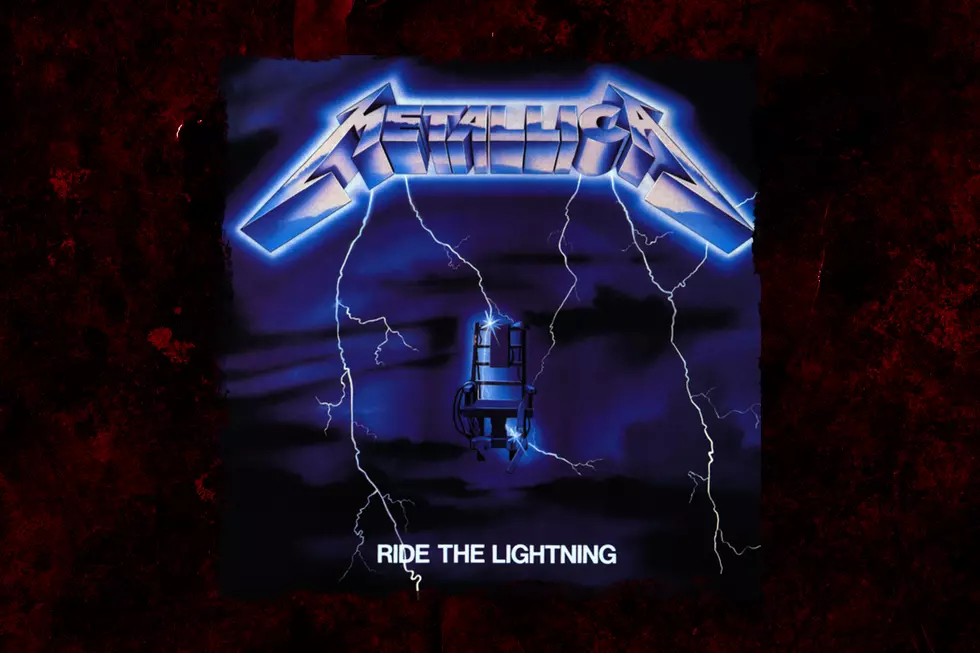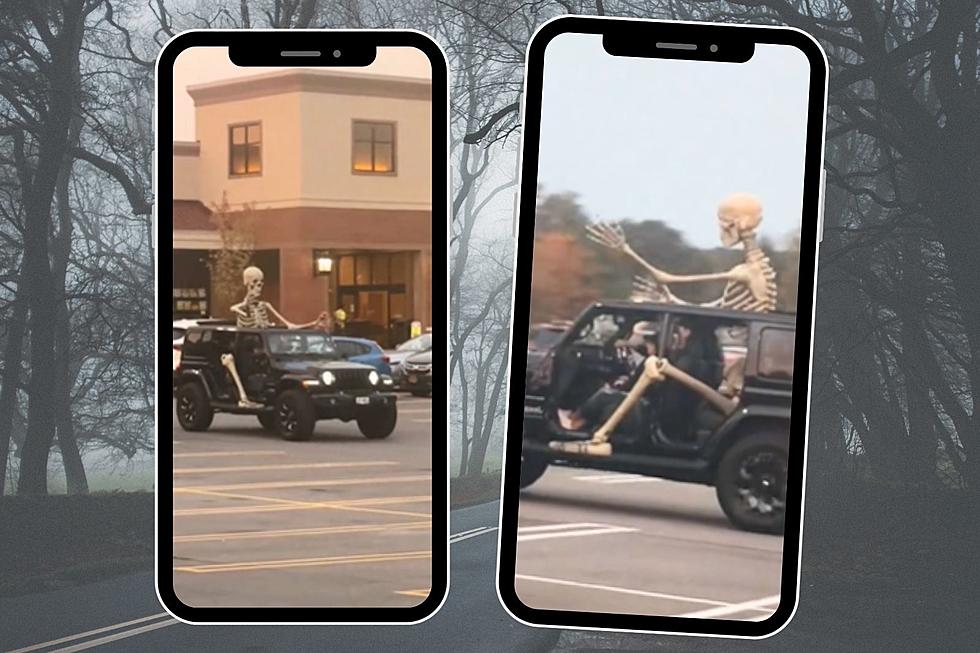
39 Years Ago – Metallica Release ‘Ride the Lightning’
After Metallica’s debut, Kill ‘Em All, became a template for a new style of music, the band realized it was going to have to up the ante on thrash metal. Slayer had released their blinding debut Show No Mercy. Anthrax put out Fistful of Metal and Metallica guitarist Kirk Hammett’s original band, Exodus, had a hot underground demo with a similar sound. As they worked on songs for their second album, Metallica were determined to stay ahead of the pack, and when Ride the Lightning came out on July 27, 1984, they proved that they weren’t just one of the best thrash bands, they were one of the best bands, period.
Guitarist James Hetfield and Lars Ulrich had written most of Metallica’s first album with Dave Mustaine. Since Mustaine was no longer in the group when the sessions for Ride the Lightning began, bassist Cliff Burton stepped to the forefront, contributing to six of the eight songs and encouraging his bandmates to experiment with different tempos and structures on songs like “Fight Fire With Fire" and the cinematic instrumental “The Call of Ktulu.”
Metallica, "Fight Fire With Fire"
Like Iron Maiden’s Steve Harris, who was one of Metallica’s musical heroes, Burton played with his fingers, imbuing the songs with fluidity. Since he had some knowledge of music theory, he showed Hetfield and Hammett how to augment core notes with complementary counter-melodies and how basic guitar harmony worked. He also enhanced the music with effect pedals, including the Morley wah-wah, which provided a sweeping, cutting sound under the metallic crunch.
“I think Cliff was the one who really taught them about melody,” adds Anthrax guitarist Scott Ian. “Cliff was the maestro. He was really accomplished and was thinking beyond thrash and metal. He always wore an R.E.M. t-shirt and a Lynyrd Skynyrd pin on his jean jacket and I think that gives you an idea of where his head was at.”
“Ride the Lightning gave Cliff a platform to shine as a songwriter and a player,” said Metal Mania fanzine founder and KUSF Ramgate Radio DJ Ron Quintana. “He could do it all. He gave Metallica many more options than just playing fast. He loved complex music. He listened to classical, Frank Zappa and it showed in his bass playing.”
In addition to burning with energy and creativity, Metallica were also extremely hungry -- literally. They were renting a house, which they called the Metallimansion, in El Cerrito, Calif., but they could barely pay their rent and they had to choose carefully between spending money on cheap eats or budget beer and liquor.
“Everyone was so poor, we were lucky if we could afford Smirnoff,” Quintana told me in 2014. “And anyone who would bring good, hard alcohol was worshipped. It was such a small house. You’d walk up the little front stairs and there was a small deck. And then inside to the right was the famous couch everyone would crash on in the main living room. And then to the left were two rooms, which is where Lars and James lived.”
“Before I went over there for the first time I thought it was going to be this really nice place,” early band photographer and current D.R.I. bassist Harald Oimoen told me in 2014. “Of course, it was the furthest thing from that you could imagine -- a total dive. They practiced out in the back in a one-car garage that barely had enough room for a car. At one point, they had to line the ground with milk crates and stand on those because whenever it rained, the water leaked in and they didn’t want to get electrocuted.”
Metallica, "Creeping Death"
It was in these cramped quarters that Metallica grew exponentially as players and songwriters and wrote some of their most heralded songs. Three months before they headed to Copenhagen, Denmark, to record Ride the Lightning, they were already playing unpolished versions of “Creeping Death,” the title track, “Fight Fire With Fire” and “The Call of Ktulu” in concert. Then, the night before a show at The Channel in Boston on January 24, 1984, someone broke into Metallica’s van and stole Ulrich’s drum kit, Hammett’s Marshall head cabinet and Hetfield’s modified Marshall head cabinet and speaker. Anthrax leant the band equipment for the remaining dates of the tour, so Metallica were still able to play the shows, but that didn’t cure the sting from losing their gear, especially for Hetfield.
Dejected by the robbery, Metallica’s frontman write a melancholy, arpeggiated melody on an acoustic guitar and penned his most vulnerable, despairing lyrics to date. “Life it seems will fade away, drifting further every day / Getting lost within myself / Nothing matters no one else / I have lost the will to live.” Coupled with the delicate guitar passage, Hetfield’s seven-minute long ode to suicide became Metallica’s first ballad, “Fade to Black.”
“I’m sure I wasn’t really thinking of killing myself,” he said in Birth School Metallica Death. “But it was my favorite Marshall amp, man!”
Metallica, "Fade to Black"
Metallica wrote the remaining three songs on Ride the Lightning, “Escape,” “Trapped Under Ice,” and “For Whom the Bell Tolls,” at Sweet Silence Studios in Copenhagen, Denmark with producer Flemming Rasmussen. The band’s manager Jonny Z chose the place because it was affordable and the band liked it because Rainbow had recorded Difficult to Cure there. Since their amps had been stolen in Boston, Metallica brought over their guitars and Rasmussen hooked them up with nine Marshalls he borrowed from Danish bands that were in town.
“[We] spent the first day testing them,” he told Rolling Stone. "We actually recreated James' guitar sound on Kill 'Em All, but just beefed it up. He was really pleased with that.”
With the amp problem solved, Rasmussen discovered a much more vexing issue. Ulrich played inventive drum fills, for sure, but when he tried to keep a straight beat for a prolonged period of time he would speed up for some parts and slow down for others. “I thought he was absolutely useless [at first],” Rasmussen told Enter Night writer Mick Wall. “The very first thing I asked when he started playing was, ‘Does everything start on an upbeat?’ And he went, ‘What’s an upbeat?’”
With the help of drum roadie Flemming Larsen, Rasmussen gave Ulrich a crash course in basic drumming. “We started telling him about [beats] -- that they have to be an equal length of time between that hit, that hit and that hit and you have to be able to count to four before you come in again.” Rasmussen said.
READ MORE: Metallica's 'Ride the Lightning': 10 Facts Only Superfans Know
Fortunately, Ulrich was a quick learner and, while some songs required more takes than others, Rasmussen was eventually able to track the drums at the right tempo without the aid of computer programs like ProTools, which had yet to be invented. Rasmussen also contributed creatively to the recording, using backwards guitar atop normal melody lines on songs like “Fade to Black” and the intro to “Fight Fire with Fire.” The creativity in the studio was infectious. Burton came up with the squiggly, descending bass pattern for “For Whom the Bell Tolls” and for the bell tones at the end of the song, Ulrich struck an anvil with a metal hammer.
In mid-March, when Metallica listened to the completed album, they were pleased at the quality and diversity of the recording. While “Fade to Black” was a standout melodic single, from the start it was clear that “Creeping Death” was a real highlight. “I sat in the control room after we did the [‘Die, die, die’] gang vocals [for the song] and everyone was going nuts,” Hetfield told Guitar World.
Metallica, "For Whom the Bell Tolls"
Elektra Records signed Metallica on Sept. 12 and re-released Ride the Lightning on Nov. 19. Four days later, they released a 12-inch for “Creeping Death,” which featured covers of “Am I Evil?” by Diamond Head and “Blitzkrieg” by Blitzkrieg. Ride the Lightning peaked at No. 100 on the Billboard album chart, and even without a music video or radio airplay, the band grew rapidly and organically. Some old-school fans felt betrayed by melodic songs like “Escape” and “For Whom the Bell Tolls,” but many more open-minded listeners applauded the diversity and new listeners who didn’t follow thrash were drawn to “Fade to Black.”
“One of the first moments when I realized things were really happening for us happened when I was at my girlfriend’s house right when Ride the Lightning came out,” Hetfield stated in Louder Than Hell: The Definitive Oral History of Metal. “I was waiting for her while her sister was home, and I don’t think she knew I was there, and I could hear ‘Fade to Black’ blasting out of her speakers in her bedroom. It’s like, no one was there to hear her listen to that. She was listening to that because she liked it and it spoke to her. That was a pretty big thing for me. You know, ‘Fade to Black’ was one of those pivotal songs for us where you had the hardcore fan that said, ‘Screw you, you sold out, you did a ballad.’ That was their simplistic thinking. Then you had the other people that said, ‘Wow no one had ever spoken to me like that in a song and I totally relate to that and it’s helped me.’”
To date, Ride the Lightning has shipped six million copies in the U.S. and more than half the album's tracks -- “Ride the Lightning,” "Creeping Death," “For Whom the Bell Tolls” and “Fade to Black” -- remain staples of the band’s live set.
Loudwire contributor Jon Wiederhorn is the author of Raising Hell: Backstage Tales From the Lives of Metal Legends, co-author of Louder Than Hell: The Definitive Oral History of Metal, as well as the co-author of Scott Ian’s autobiography, I’m the Man: The Story of That Guy From Anthrax, and Al Jourgensen’s autobiography, Ministry: The Lost Gospels According to Al Jourgensen and the Agnostic Front book My Riot! Grit, Guts and Glory.
Top 80 Hard Rock + Metal Albums of the 1980s
More From Ultimate Metallica










